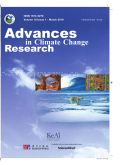- 钛学术文献服务平台 \
- 学术期刊 \
- 基础科学期刊 \
- 天文学、地球科学期刊 \
- 气候变化研究进展(英文版)期刊 \
Impact of cropland degradation in the rural-urban fringe on urban heat island and heat stress during summer heat waves in the Yangtze River Delta
Impact of cropland degradation in the rural-urban fringe on urban heat island and heat stress during summer heat waves in the Yangtze River Delta
基本信息来源于合作网站,原文需代理用户跳转至来源网站获取
摘要:
China has experienced rapid urbanization since the 1980s,which has significantly reduced croplands around cities.Apart from transition to urban land,croplands have also experienced degradation into cropland/natural vegetation mosaic in the rural-urban fringe.However,scant attention has been paid to the climatic effect of such land cover change so far.This study thus investigated the potential impacts of the conversion from irrigated cropland into the mosaic on regional hot extremes and heat stress by taking the Yangtze River Delta(YRD)as an example.Four heatwave events in the summer of 2013 and 2017 were simulated using the Weather Research and Forecasting Model(WRF).Three group experiments with various representative land cover scenarios,i.e.,a default setting experiment with outdated land cover(Exp USGS),a control experiment with updated land cover(CTL),and a sensitivity experiment with modified mosaic land cover(Exp MOS),were performed for comparative analyses.Results show that CTL using the updated land cover data from China(ChinaLC)reproduced the spatial variation of observed 2-m air temperature and relative humidity better than Exp USGS.After the irrigated cropland was converted into the mosaic,the 2-m temperatures in most areas of the YRD became significantly higher than those in Exp MOS due to the lower albedo and leaf area index(LAI)in the newly emerged mosaic areas.The land cover change produced a negative contribution to the urban heat island(UHI)intensity,while it had a positive effect on extreme high temperature under heat wave conditions.This suggests a more cautious usage of the traditional definition of the UHI index is required when investigating the heat island effect,because the rural warming around an urban area may expand the heat island and enhance its heat effect.During the heatwave periods,the high temperature areas in CTL were larger than those in MOS,and the hot day areas increased by an average of 25.9%.Increase in air temperature further enhanced regional heat stress.Those results imply that the effects of land cover change in the rural-urban fringe may increase the risks of extreme hot events and heat stress for urban residents under global warming.

推荐文章
Assessment of bacterial biomass in the highly contaminated urban Nanming River, Guiyang, SW China
δ13C
δ15N
Bacterial biomass
N budget
Nanming River
土地财政对城市土地利用效率的影响——基于空间计量模型的实证分析
土地财政
土地利用效率
空间杜宾模型
内容分析
关键词云
关键词热度
相关文献总数
(/次)
(/年)
文献信息
| 篇名 | Impact of cropland degradation in the rural-urban fringe on urban heat island and heat stress during summer heat waves in the Yangtze River Delta | ||
| 来源期刊 | 气候变化研究进展(英文版) | 学科 | |
| 关键词 | |||
| 年,卷(期) | 2022,(2) | 所属期刊栏目 | Changes in climate system |
| 研究方向 | 页码范围 | 240-250 | |
| 页数 | 11页 | 分类号 | |
| 字数 | 语种 | 英文 | |
| DOI | |||
五维指标
引文网络
引文网络
二级参考文献 (0)
共引文献 (0)
参考文献 (0)
节点文献
引证文献 (0)
同被引文献 (0)
二级引证文献 (0)
2022(0)
- 参考文献(0)
- 二级参考文献(0)
- 引证文献(0)
- 二级引证文献(0)
引文网络交叉学科
相关学者/机构
期刊影响力
气候变化研究进展(英文版)
主办单位:
国家气候中心
出版周期:
季刊
ISSN:
1674-9278
CN:
11-5918/ P
开本:
16开
出版地:
北京市中关村南大街46号国家气候中心
邮发代号:
创刊时间:
2010
语种:
eng
出版文献量(篇)
377
总下载数(次)
0
总被引数(次)
708
期刊文献
相关文献
推荐文献
- 期刊分类
- 期刊(年)
- 期刊(期)
- 期刊推荐
力学
化学
地球物理学
地质学
基础科学综合
大学学报
天文学
天文学、地球科学
数学
气象学
海洋学
物理学
生物学
生物科学
自然地理学和测绘学
自然科学总论
自然科学理论与方法
资源科学
非线性科学与系统科学
气候变化研究进展(英文版)2022
气候变化研究进展(英文版)2021
气候变化研究进展(英文版)2020
气候变化研究进展(英文版)2019
气候变化研究进展(英文版)2018
气候变化研究进展(英文版)2017
气候变化研究进展(英文版)2016
气候变化研究进展(英文版)2015
气候变化研究进展(英文版)2014
气候变化研究进展(英文版)2013
气候变化研究进展(英文版)2012
气候变化研究进展(英文版)2011
气候变化研究进展(英文版)2010

 免费查重
免费查重










